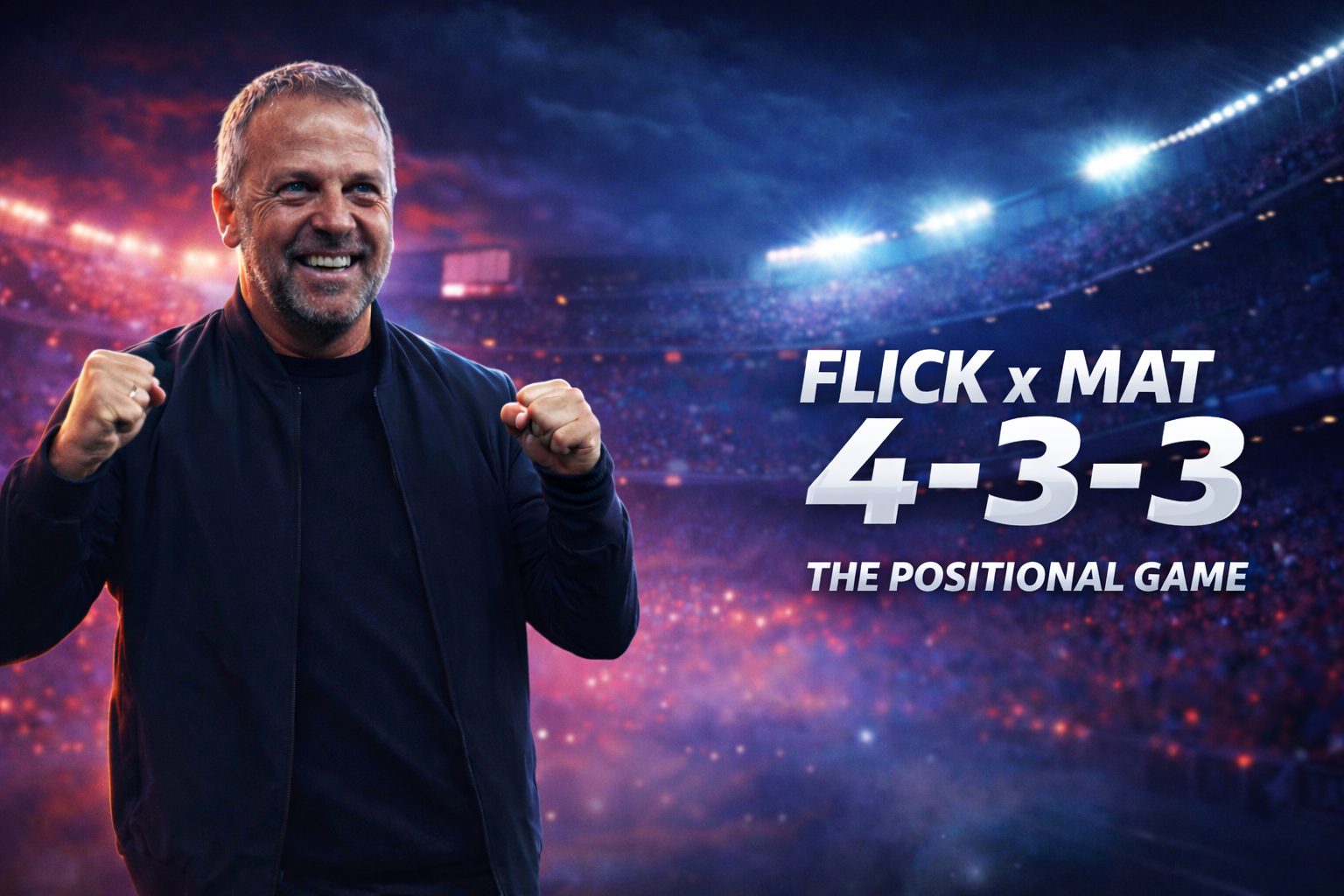FERNANDO DINIZ'S RELATIONISM: FLUMINENSE TACTIC ANALYSIS AND RECREATION ON FM 24 WON 4 TROPHIES OF 5
Fernando Diniz's Fluminense Tactic
Fernando Diniz's Fluminense represents a significant case study in contemporary football. His playing philosophy, centered on principles of relationalism and an advanced interpretation of possession-based play, has generated a complex and dynamic tactical model. This article delves into the strategic mechanisms underpinning Diniz's approach, analyzing how nominal formations translate into fluid on-field structures, the roles of individual players, and the application of fundamental principles that define its effectiveness.
Build-Up Play: Synchronicity and Numerical Superiority
Diniz's Fluminense is known for a distinctive style emphasizing relational play and a fluid build-up. Central to Diniz's philosophy is the concept of relationalism, which focuses on the synchronization and interconnectedness of players across the pitch. This approach fosters cohesive player relationships, enabling intricate passing sequences and fluid off-the-ball movement. In the build-up phase, Fluminense prioritizes maintaining possession through precise passing triangles and dynamic positional rotations. Diniz encourages players to constantly adjust their positions, creating passing lanes and numerical superiority, allowing the team to control the tempo and dictate play from the back. Typically, Fluminense operates in a 4-2-3-1 formation, though this frequently shifts during the game.
Creating Numerical Advantages
One of the standout features of Fluminense's build-up is their ability to create numerical advantages in various areas of the pitch. Their fluidity and continuous rotations are structured to exploit spaces where the opposition is vulnerable, often targeting the opposition's fullback by concentrating players in that area to gain a tactical edge.
Fluminense is adept at exploiting these numerical advantages. Once the ball is with a player, they often lure an opposition defender out of position. This opens up space behind the defender, allowing other Fluminense players to move into the open areas and receive the ball.
Low Build-Up: Overcoming the Press
In the low build-up phase, Diniz emphasizes bringing multiple players deep to create numerical superiorities, typically allowing them to beat the opponent's press. If the opposition responds by pushing up and marking man-to-man, Fluminense can bypass this with a long ball, setting up a 2v2 or 3v3 situation upfront.
Goal Kicks: Space Dynamics
During goal kicks, a holding midfielder frequently drops into the penalty area to receive the ball from the goalkeeper. This movement forces an opposition midfielder to advance, creating space in the midfield. A Fluminense midfielder can then drop into this space to receive the ball. If the opposition presses this midfielder, additional space higher up the pitch opens for Fluminense's forwards to exploit.
High Build-Up: Compactness and Space Exploitation
In the high build-up phase, Diniz's Fluminense often shifts to one side of the pitch, concentrating players near the ball (except for the weak-side fullback). This clustering of players offers multiple options for the ball carrier while reducing space between players. Diniz favors this setup as it supports defensive transitions and simplifies breaking through the opposition. Keeping players close together also shortens passing distances, accelerating the pace of play and limiting the opposition's pressing opportunities.
Because they focus on one side, Fluminense rarely switches play, but sometimes leverages the open weak-side fullback to create 1v1 situations through quick switches.
High Defensive Line: A Counter-Pressing Catalyst
A key aspect of Fluminense's high build-up is their use of a high defensive line. This strategy aids in counter-pressing by positioning players closer to the center of the pitch, making it difficult for opponents to retain possession. Additionally, the high defensive line compresses the field, shortening passing distances and preventing the opposition from advancing.
Final Third Play: Creativity and Overloads
Attacking the Half-Spaces: Penetration Zones
Fluminense excels in the final third, particularly by attacking the space between the opposition's center-back and fullback, known as the "half-space." This is often executed from wide areas, with midfielders making underlapping runs.
Overlaps: Creating Numerical Superiority Out Wide
The team also employs overlaps to create chances. When a winger receives the ball, a teammate quickly overlaps, creating a 2v1 situation on the wing. Depending on the opposition fullback's response, this can lead to a shot, a combination with a midfielder, or a crossing opportunity.
Flooding the Box: Disorienting the Defense
Fluminense frequently commits multiple players to the box in the final third, often deploying four or five players to create overloads. These numerical advantages force the defense to make difficult decisions, often leaving some players unmarked.
Diniz also positions players outside the box, ready to capitalize on second balls or cut-backs. This setup helps Fluminense push the opposition's defense back, opening up spaces in front of the backline for midfielders to exploit with shots or combinations.
Back Post Play: Germán Cano's Artistry
The Fluminense striker often positions himself on the blindside of the weak-side center-back, making it difficult for defenders to track his movements. The back post typically offers space, and the player marking this area, often a fullback, is usually less skilled in aerial duels. Germán Cano has mastered this tactic, frequently scoring from such positions.
Core Principles and Tactical Mechanisms
Possession Retention: Systemic Control and Fluidity
Under Fernando Diniz, Fluminense epitomizes a possession-oriented style that emphasizes control and fluidity. Diniz instills a philosophy rooted in ball retention, urging players to circulate the ball patiently while probing for openings in the opposition's defense. The team showcases intricate passing sequences, often building from the back with composure. Players are instructed to constantly seek numerical superiorities, using short, quick passes to maintain possession and control the game's tempo.
Third-Man Principle: Unlocking Passing Lanes
Fluminense often employs the third-man principle, a key tactic in breaking through opposition defenses. This involves using a third player to reach a free teammate whose direct passing lane is blocked.
Bounce-Passes: Attraction and Space Creation
The team also uses bounce-passes (quick one-twos) to draw out opposition players and open up passing lanes. By playing quick one-twos, they force opponents to press, which creates gaps in the defensive structure.
Give and Go: Continuous Movement
A crucial element of Diniz's philosophy is the constant movement after passing. This fluidity allows players to occupy new positions and create fresh passing options, enhancing the team's dynamism and unpredictability.
One-Twos: The Heart of Build-Up and Penetration
Extending the concept of continuous movement, Fluminense frequently utilizes one-twos. After passing, players immediately move to offer the option of a return pass in a different space, making this tactic difficult to defend and integral to their build-up.
Diagonal Lines (Escandinha): Defensive Disorientation
Fluminense also creates diagonal lines between players, often forming groups of three or four to penetrate opposition defenses. The middle player in these lines may make a run to open up a passing lane to the furthest player, confusing defenders about who will receive the ball.
Defensive Strategy: Aggression and Spatial Compression
High Press: An Offensive Weapon
Diniz emphasizes aggression without the ball, as seen in Fluminense's high press. The team typically goes man-to-man and applies intense pressure, using the high press almost as an offensive strategy, often scoring from winning the ball back high up the pitch.
Low Press: Central Closure and Directed Play
In a low press, Fluminense adopts a 4-4-2 formation, setting up in a mid-block. They focus on closing the center and forcing the opposition wide.
Fluminense aims to compress the field when defending, constantly pushing up whenever the opponent plays a slow or back pass. This strategy drives the opponent further from Fluminense's goal, reducing their ability to create chances.
Defensive Transitions: Immediate Possession Recovery
By positioning many players on one side and creating numerical advantages, Fluminense is optimally prepared for defensive transitions. When they lose the ball, they can quickly regain possession through counter-pressing, often pushing the opposition towards the sideline to limit their options and regain control of the game.
Final Considerations
In conclusion, Fernando Diniz's tenure at Fluminense represented a fascinating blend of tactical innovation and strategic sophistication. His commitment to expansive, possession-based football redefined the team's playing style and left a significant impact on Brazilian football. This analysis has highlighted Diniz's meticulous attention to detail, emphasizing fluidity, movement, and rapid transitions. His ability to implement a coherent tactical framework allowed Fluminense to compete at the highest levels, challenging traditional norms and showcasing a visually impactful style of play.
Although Diniz is no longer at the helm of Fluminense, his distinctive tactical approach continues to be a subject of study and admiration. His impact on the team and his contribution to the evolution of modern football remain an important chapter in his career
Replicating Fernando Diniz's Tactics in Football Manager 2024: A Complete Guide
Fernando Diniz's tactical philosophy, epitomized by his work at Fluminense and characterized by relational play, intense ball possession, and fluid movements, presents a stimulating challenge for any Football Manager 2024 strategist. Faithfully replicating such an organic system, built on the synchronicity of players, requires a deep understanding of team instructions and individual roles. This guide will walk you step-by-step through creating a tactic inspired by Diniz's principles, explaining the reasoning behind each choice.
1. Game Mentality and General Overview
Let's summarize the key characteristics of Diniz's play:
Mentality: Maintain possession. This is the foundation of Diniz's game. It allows the team to keep possession, look for openings, and advance patiently.
Narrow play: although relational play might seem "wide," Diniz's hallmark is the concentration of players near the ball to create numerical superiority, favoring short, quick passes. This deliberately creates a confined space where the game develops.
Short passing: essential for possession and combination play.
Slightly higher tempo: this reflects patience in build-up and the search for the right moment to accelerate, progressing the ball forward.
Passing Focus: Prioritize passing and combination play over individual actions.
2. Team Instructions
[img] https://fmshots.com/image/wtKVBU[/img]
Positive Mentality
In Possession
[img] https://fmshots.com/image/wtKxkI[/img]
This is where the essence of Diniz's "relationalism" and build-up play is defined:
Much Pass it shorter: Crucial for maintaining possession and encouraging close combinations.
Pass Into Space: Playing the ball into forward spaces for better-positioned teammates helps replicate Fernando Diniz's "give and go" play.
Work Ball Into Box: This encourages the team to bring the ball into the area with passes and movements, rather than seeking long balls or long-range shots.
Narrow Width: This encourages players to stay compact and close to each other, occupying the central areas of the pitch.
Underlap (left and right): In Diniz's play, players' forward movements mainly occur in central areas of the field, seeking to gain numerical superiority in the central opposition half, particularly near the penalty area. With frequent through balls, players look to run into spaces, especially between the opponent's full-back and center-back.
Slightly Higher Tempo: Encourages players to bring the ball into the opponent's half more quickly.
Be more expressive: Indispensable for relational play and the positional adaptability of players. It allows for rotations and position swaps.
Play Out Of Defense: Fundamental for deep build-up and managing possession right from the goalkeeper.
Low crosses to exploit cutbacks.
In Transition
[img] https://fmshots.com/image/wtKZUN[/img]
These instructions manage the shift from one phase to another:
When Possession Is Lost:
Counter-Press: Diniz emphasizes immediate aggression to win the ball back high up the pitch.
When Possession Is Won:
Hold Shape: Fluminense doesn't rush into quick counter-attacks; they prefer to rebuild possession.
Goalkeeper: Distribute to Center-Backs: To encourage build-up from the back.
Goalkeeper: Take Short Kicks: To maintain possession right from the goalkeeper.
Out of Possession
[img] https://fmshots.com/image/wtKmKK[/img]
Here, we replicate the defensive aggression and compression:
Much Higher Defensive Line: Essential for high pressing and compressing the field.
Higher Pressing Line: To initiate aggressive pressing right from the attack.
Much More Intense Pressing: To man-mark and apply constant pressure on the opponent.
Prevent Short Goalkeeper Distribution: To stop the opponent's build-up from the back.
Step Up More: In combination with the much higher line, this asks the defensive line to push up to apply the offside trap.
Trap outside: Again, to force the opponent to play down the wings and compress the central space.
3. Player Roles and Duties (and Individual Instructions)
This is the most delicate part of replicating Diniz's "relationalism." Each role is chosen to favor fluidity and proximity, allowing for exchanges and combinations.
Goalkeeper
Sweeper Keeper (Support): Participates in deep build-up and drops back to create superiority. No specific instructions needed.
Center-Backs
Ball Playing Defender (Defend): Both must be skilled at passing to initiate build-up from the back.
Full-Backs
Inverted Full-Back (Support): Both full-backs move centrally to create numerical superiority in midfield, favoring tight combinations. Personal Instructions: Pass it shorter, Get Further Forward.
Central Midfielders
Roaming Playmaker (Support): This is the pivot of the game, receiving the ball from defenders and orchestrating the first plays. Starts on the right but moves extensively in central areas of the pitch, also covering the left side when the other midfielder pushes forward. Personal Instructions: Pass it shorter.
Segundo Volante (Support): Offers dynamism, runs into space, and support in both phases. Their energy is crucial for pressing. Personal Instructions: Move Into Channels, Pass it shorter, Get Further Forward.
Attacking Midfielder
Advanced Playmaker (Support): Fundamental for playing between the lines and creating links. This is the perfect role for a player like Ganso. Personal Instructions: Pass it shorter, roam from position.
Wingers/Wide Forwards
Inside Forward (Support): Both cut inside to combine and attack the spaces between the opponent's center-backs and full-backs. They often swap positions with each other or with the attacking midfielder, confusing opposing defenders. Personal Instructions: Roam From Position, Sit Narrower, Pass it shorter.
Central Striker
Deep-Lying Forward (Attack): Like Germán Cano, they must be a clinical finisher capable of attacking the far post. Personal Instructions: Pass it shorter, Roam From Position.
4. Analysis and Reasoning Behind the Choices
Relationalism and Fluidity: The instructions Roam From Position, Move Into Channels, and Pass it shorter for almost all players are crucial to encourage positional exchanges and tight combinations. The Extremely Narrow Width also serves this purpose. The roles of Roaming Playmaker (a role that by definition favors midfield rotations) and Advanced Playmaker behind the striker (instead of an attacking midfielder) are also important.
Build-Up From the Back: The Sweeper Keeper and Ball Playing Defenders with instructions for Pass it shorter and Distribute to Center-Backs form the foundation.
Numerical Advantages: The choice of two Inverted Full-Backs and the concentration of players through Narrow Width constantly creates superiority in midfield and on the ball side.
Attacking Spaces Between Full-Back and Center-Back: The Inside Forwards and Mezzala with the Move Into Channels instruction are the main executors of this tactic, seeking runs between the center-back and full-back.
High Pressing and Gegenpressing: The Much Higher Defensive Line and Higher Pressing Line combined with Counter-Press and Much More Intense Pressing replicate Diniz's aggression without the ball, turning ball recovery into an offensive opportunity.
Crowding the Box: The Pressing Forward (Attack) with the Move Into Channels instruction and the tendency of Inside Forwards to cut into the area, along with the Work Ball Into Box instruction, encourage a massive presence of players in the goal area.
Final Considerations for Football Manager
Replicating Diniz won't be simple, as FM can't perfectly simulate human relational dynamics. However, with these settings, you'll have a solid base that encourages the type of football Diniz prefers: patient possession, fluid movements, constant numerical superiority, and immediate aggression when out of possession.
Additional Tips:
Training: Focus on Tactics and Team Cohesion training. Also work on Possession, Attacking (for combinations), and Defending (for pressing).
Roles and Attributes: Look for players with high attributes in Decisions, Vision, Technique, Passing, Off the Ball, and Determination. Stamina will be fundamental for pressing and constant movement.
Patience: Initially, the team might struggle to assimilate the system. Give players time to get used to the instructions and roles. Analyze in-game statistics and heatmaps to see if movements are occurring as expected.
Results
I tested this tactic with Fluminense during 1 year winning Campeonato Carioca, Campeonato Brasileiro, Copa Libertadores, Recopa Sudamericana and Copa do Brasil. I got knocked out in Qauarter Finals of FIFA Club World Cup by Paris Saint-Germain.
[img] https://fmshots.com/image/wtKvuj[/img]
[img] https://fmshots.com/image/wtKCCs[/img]
More details in my youtube video here
If you want to support me you can subscribe to my channel or to my Patreon too
Enter text for the link here...
Thanks everyone











Discussion: DINIZ RELATIONAL PLAY FLUMINENSE 4-2-3-1
No comments have been posted yet..